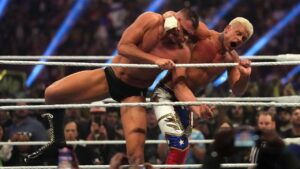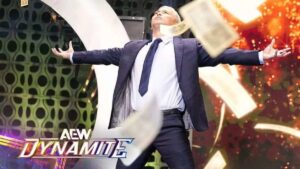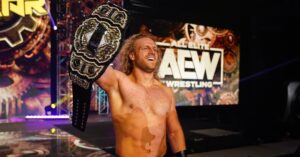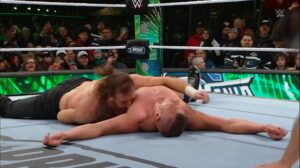In August 1998, World Wrestling Entertainment (WWE) launched Sunday Night Heat. It was a bid to capitalize on the Attitude Era’s popularity. The aim was to have an extra hour of programming to continue storylines from Monday Night Raw and give some of WWE’s mid-carders more ring time.
On the October 4, 1998 episode of Heat, “Stone Cold” Steve Austin exploited Vince McMahon being hauled up in a hospital bed and went on a legendary rampage. If Heat was supposed to provide a prelude to the next night’s Raw, this was a perfect teaser.
On Raw, Austin invaded McMahon’s hospital room and hit him across the head with a bedpan before pulling a gun on his nemesis. In moments like this, Sunday Night Heat fulfilled the hopes of WWE’s higher-ups. It also created a legacy beyond this that is seen every week in WWE. So, let’s take a look at the true legacy of Sunday Night Heat.
https://twitter.com/90sWWE/status/1443208539443449868
The Legacy of Sunday Night Heat
Shane O’Mac Brings the Heat to Commentary
The inaugural Heat began with a moment that changed WWE forever. Vince McMahon stepped out to a chorus of boos from the crowd at the Arrowhead Pond in Anaheim, California, and introduced the world to his son, Shane McMahon. Shane had been seen a handful of times in the background of segments involving his father and “Stone Cold” Steve Austin, but this was his first proper gig in WWE.
Shane came swaggering down to the announcement desk with a model on each arm to call the action alongside Jerry Lawler and Jim Ross (JR). The McMahon son may have appropriated The Godfather’s gimmick, but his commentary style was original. Shane spent as much time chatting up his dates for the evening as he did calling play-by-play of the matches.
When he did look up from the Playboy model’s cleavage next to him, he would mostly ask JR what was going on? Some would argue he was a terrible commentator. However, he wasn’t there to be groomed into the next Bobby Heenan or Jessie Ventura. He was the spoiled and obnoxious son of the boss that was doing whatever he wanted and getting away with it. He was a perfect Attitude Era character.
“Shane O’Mac” would move away from the Heat commentary desk after less than a year and start a feud with X-Pac for the European Championship. Shane shocked everyone with his in-ring skills and carved out a niche for himself as a risk-taker. He joined his father’s Corporation stable and became one of the most recognizable on-screen personalities. Shane is now a well-respected legacy talent. Being able to find his feet on Heat certainly helped Shane grow into the performer we know.
Trish and Lita
“Shane O’Mac” wasn’t the only megastar who cut his teeth on Sunday Night Heat. Arguably the two biggest women’s wrestlers the WWE has ever produced both made their debuts on Heat.
Mexican sensation Essa Rios captured the Light Heavyweight Championship in his debut match against Gillberg on February 13, 2000, but it was his valet that caught everyone’s eye. With long red hair and a skin-tight catsuit to boot, it was the first look at Lita. She grabbed attention by entering the ring after Rios’s matches and hitting a top-rope moonsault to the defeated opponent. Lita soon swapped the catsuit for baggy jeans and her iconic thong and aligned herself with Matt and Jeff Hardy. This sparked her rise to superstardom that saw multiple title victories.
Her most famous adversary, Trish Stratus, also first appeared on Heat. Stratus scouted Test and Albert during their matches on the March 19, 2000 episode. She followed this up by introducing her T&A team to the Raw crowd the next night. Stratus would go on the become one of the most decorated female performers in WWE history. It was another example of how WWE exploited having the extra hour a day before Raw to build things up.
‘Earlier on Sunday Night Heat’
But WWE didn’t stop by simply using Heat to hype Raw, which was taped immediately after the flagship show. One Sunday every month, WWE aired Heat as a live build-up for its monthly PPV events. As well as a couple of live matches to get the PPV crowd riled up, pre-PPV Heat episodes would be an unpredictable hour of TV where anything could happen. Events ranged from beatdowns to add final fire ahead of matches on the PPV card and debuting superstars to shocking title changes.
It may also been as simple as “Stone Cold” arriving at the arena. The most iconic example was in 1999 during the pre-Royal Rumble Heat when Mr. McMahon banned all automobiles from the arena except limousines. This was part of his plan to stop “Stone Cold” from entering the building and competing in the Rumble match. Vince announced during Heat that Austin had 30 minutes to arrive or he would be eliminated from the Rumble before the PPV had even begun.
A countdown clock helped build up the tension as Heat progressed. Just in time, Austin entered the building in a monster truck limousine, crushing a few cars on his way. It was one of the most iconic moments in WWE history and helped to cement Heat as a must-watch ahead of PPVs.
The Original PPV Kickoff Show
Extreme Championship Wrestling legend Jerry Lynn made his WWE debut on the Heat show before Backlash 2001 and defeated Crash Holly for the Light Heavyweight Championship. Unfortunately for Lynn, it would go down as his finest moment during a short run in WWE. Michael Cole also cut his teeth getting final interviews from competitors before the PPV started proper.
If this all sounds a bit familiar, it’s because long after WWE retired the Heat brand it kept the premise of PPV Heat with the PPV Kickoff show, albeit with a calmer talk show aesthetic. The Kickoff still acts as a final advert for what’s about to come and occasionally adds some surprise swerves such as title changes or backstage confrontations. It isn’t just WWE that continues the legacy of the PPV pre-show created during the Heat era. All Elite Wrestling’s PPV pre-show Buy-In events are essentially episodes of Sunday Night Heat.
Halftime Heat And SmackDown’s Impact
Sunday Night Heat involved plenty of incredible matches with Stone Cold, The Rock, Triple H, The Undertaker, Kane, Mankind, and Vince McMahon appearing on most shows. The most legendary of these is no doubt The Rock vs. Mankind in an empty arena match during a special Halftime Heat to coincide with Super Bowl XXXIII on January 31, 1999.
However, the show underwent a dramatic change when WWE launched SmackDown in August 1999. Heat had proven, for 12 months, that there was an appetite for multiple WWE programs throughout the week. Thus, the company went ahead with SmackDown. Filmed in its own arena, with a unique stage set and lasting double the time of Heat, there was no doubt that SmackDown was now the second show.
Enhancement Show
Slowly the WWE writers chose to keep their best ideas – and superstars – for Raw and SmackDown and Heat became the ‘enhancement show’. In a similar vein to early NXT, hardcore fans still tuned in to Heat to get a glimpse at a potential debut or a drastic new gimmick. Plus, fans of the mid-card division of the late 90s/early 00s were in their dreamland with Heat.
The show soon centered around the more over-the-top superstars such as Grandmaster Sexay, Scotty 2 Hotty, The Godfather, Gangrel, Crash Holly, Val Venis, Perry Saturn, Taka Michinoku, Funaki, and many more. When WWE acquired World Championship Wrestling, Heat also seemed to be the only place to see workers such as Haku, Mr. Perfect, Billy Kidman, Hurricane Helms, and Chris Kanyon.
The Final Days Of Sunday Night Heat
Great matches still happened on Heat. Despite many viewing the prospect of Mr. Perfect and Rob Van Dam going one on one in the ring as a dream match, WWE officials only saw it as fit for Heat. It was, unsurprisingly, fantastic.
During Kurt Angle’s first heavyweight championship run in late 2000, he defended his title against Crash Holly on Heat. It was a brilliant match that involved plenty of offense from Holly and a few close calls for the challenger.
As the new millennium continued and WWE went through several changes, such as the brand split, Heat underwent one final change that would impact WWE broadcasting. When the USA Network chose not to pick up Heat, WWE aired it on its website. This marked the first time WWE had seemingly given away its programming online and set the ball in motion for its website including more original content. After 513 episodes, WWE uploaded the final ever Heat to WWE.com. The first two years of Heat are available on the WWE Network, but its legacy lives on in almost all of the content of the promotion.






